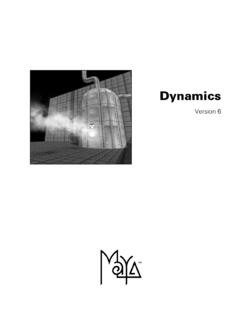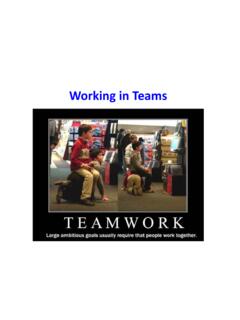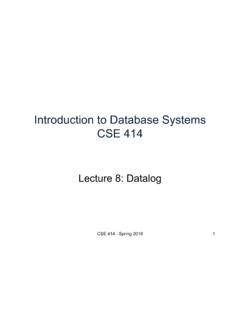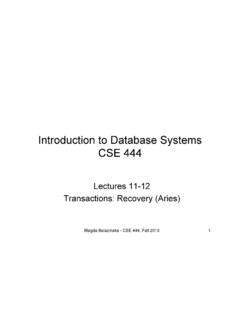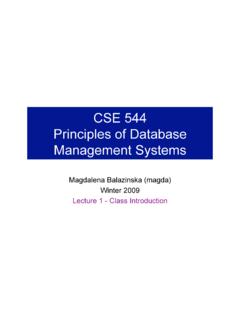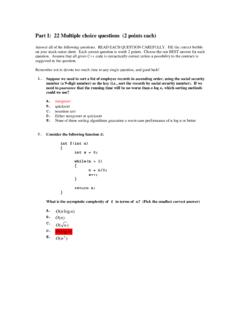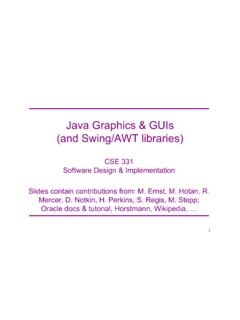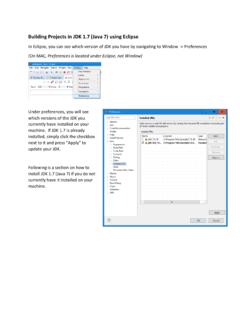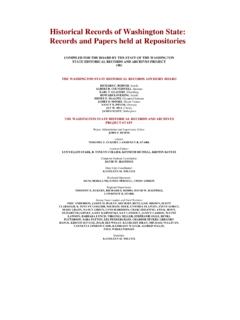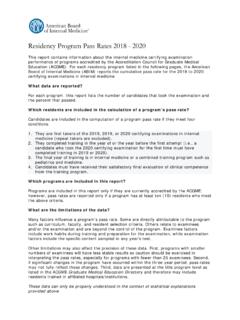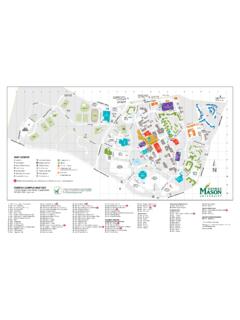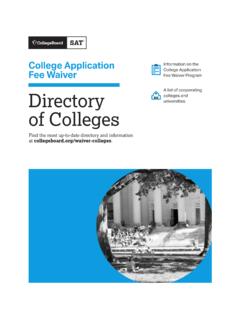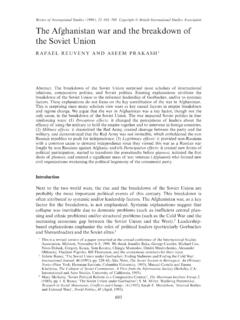Transcription of The History of Artificial Intelligence
1 1 The History of Artificial Intelligence History of Computing CSEP 590A university of washington December 2006 Introduction Chris Smith The Turing Test Brian McGuire History of AI applied to Chess Chris Smith Expert Systems Ting Huang AI Winter and its lessons Gary Yang Japan's Fifth Generation Computer System project Chris Smith Conclusion Chris Smith 2 Table of Contents Introduction .. 4 Artificial Intelligence .. 4 Themes of AI .. 4 The Turing Test .. 5 Introduction .. 5 Alan Turing .. 5 Inception of the Turing Test .. 6 Problems/Difficulties with the Turing Test .. 6 Alternatives to the Turing Test .. 7 The Current State of the Turing Test .. 8 Conclusion .. 9 History of AI applied to Chess .. 10 Origins of 10 Realization .. 10 Go as the next frontier .. 11 Conclusion .. 11 Expert Systems .. 12 Overview .. 12 Key Technological Issues .. 12 Managerial and Organizational Challenges .. 14 Is "Thinking" Machine Ever Possible.
2 14 Social Implications of Expert Systems .. 15 Concluding 16 AI Winter and its lessons .. 17 Overview .. 17 Trigger of AI Winter .. 17 The ALPAC report .. 17 The Lighthill report .. 18 The Duration of AI Winter .. 18 19 3 Conclusion .. 21 Japan's Fifth Generation Computer System project .. 22 Motivations and 22 Progress made on FGCS .. 23 23 Failures .. 23 Lessons learned .. 23 Conclusion .. 24 References .. 25 Introduction, History of AI applied to Chess, and Japan's FGCS .. 25 Turing Test .. 25 AI Winter .. 26 Expert Systems .. 26 4 Introduction Artificial Intelligence (AI) has been studied for decades and is still one of the most elusive subjects in Computer Science. This partly due to how large and nebulous the subject is. AI ranges from machines truly capable of thinking to search algorithms used to play board games. It has applications in nearly every way we use computers in society. This paper is about examining the History of Artificial Intelligence from theory to practice and from its rise to fall, highlighting a few major themes and advances.
3 Artificial Intelligence The term Artificial Intelligence was first coined by John McCarthy in 1956 when he held the first academic conference on the subject. But the journey to understand if machines can truly think began much before that. In Vannevar Bush s seminal work As We May Think [Bush45] he proposed a system which amplifies people s own knowledge and understanding. Five years later Alan Turing wrote a paper on the notion of machines being able to simulate human beings and the ability to do intelligent things, such as play Chess [Turing50]. No one can refute a computer s ability to process logic. But to many it is unknown if a machine can think. The precise definition of think is important because there has been some strong opposition as to whether or not this notion is even possible. For example, there is the so-called Chinese room argument [Searle80]. Imagine someone is locked in a room, where they were passed notes in Chinese.
4 Using an entire library of rules and look-up tables they would be able to produce valid responses in Chinese, but would they really understand the language? The argument is that since computers would always be applying rote fact lookup they could never understand a subject. This argument has been refuted in numerous ways by researchers, but it does undermine people s faith in machines and so-called expert systems in life-critical applications. Themes of AI The main advances over the past sixty years have been advances in search algorithms, machine learning algorithms, and integrating statistical analysis into understanding the world at large. However most of the breakthroughs in AI aren t noticeable to most people. Rather than talking machines used to pilot space ships to Jupiter, AI is used in more subtle ways such as examining purchase histories and influence marketing decisions [Shaw01].
5 What most people think of as true AI hasn t experienced rapid progress over the decades. A common theme in the field has been to overestimate the difficulty of foundational problems. Significant AI breakthroughs have been promised in 10 years for the past 60 years. In addition, there is a tendency to redefine what intelligent means after machines have mastered an area or problem. This so-called AI Effect contributed to the downfall of US-based AI research in the 80s. In the field of AI expectations seem to always outpace the reality. After decades of research, no computer has come close to passing the Turing Test (a model for measuring Intelligence ); Expert Systems have grown but have not become as common as human experts; and while we ve built software that can beat humans at some games, open ended games are still far from the mastery of computers. Is the problem simply that we haven t focused enough resources on basic research, as is seen in the AI winter section, or is the complexity of AI one that we haven t yet come to grasp yet?
6 (And instead, like in the case of computer Chess, we focus on much more specialized problems rather than understanding the notion of understanding in a problem domain.) This paper will go into some of these themes to provide a better understanding for the field of AI and how it has developed over the years. In looking at some of the key areas of AI work and the forces that drove them, perhaps we can better understand future developments in the field. 5 The Turing Test Introduction The Turing test is a central , long term goal for AI research will we ever be able to build a computer that can sufficiently imitate a human to the point where a suspicious judge cannot tell the difference between human and machine? From its inception it has followed a path similar to much of the AI research. Initially it looked to be difficult but possible (once hardware technology reached a certain point), only to reveal itself to be far more complicated than initially thought with progress slowing to the point that some wonder if it will ever be reached.
7 Despite decades of research and great technological advances the Turing test still sets a goal that AI researchers strive toward while finding along the way how much further we are from realizing it. In 1950 English Mathematician Alan Turing published a paper entitled Computing Machinery and Intelligence which opened the doors to the field that would be called AI. This was years before the community adopted the term Artificial Intelligence as coined by John McCarthy[2]. The paper itself began by posing the simple question, Can machines think? *1+. Turing then went on to propose a method for evaluating whether machines can think, which came to be known as the Turing test. The test, or Imitation Game as it was called in the paper, was put forth as a simple test that could be used to prove that machines could think. The Turing test takes a simple pragmatic approach, assuming that a computer that is indistinguishable from an intelligent human actually has shown that machines can think.
8 The idea of such a long term, difficult problem was a key to defining the field of AI because it cuts to the heart of the matter rather than solving a small problem it defines an end goal that can pull research down many paths. Without a vision of what AI could achieve, the field itself might never have formed or simply remained a branch of math or philosophy. The fact that the Turing test is still discussed and researchers attempt to produce software capable of passing it are indications that Alan Turing and the proposed test provided a strong and useful vision to the field of AI. It s relevance to this day seems to indicate that it will be a goal for the field for many years to come and a necessary marker in tracking the progress of the AI field as a whole. This section will explore the History of the Turing test, evaluate its validity, describe the current attempts at passing it and conclude with the possible future directions the Turing test solution may take.
9 Alan Turing Alan Turing was an English mathematician who is often referred to as the father of modern computer science[3]. Born in 1911, he showed great skill with mathematics and after graduating from college he published a paper On Computable Numbers, with an Application to the Entscheidungs problem in which he proposed what would later be known as a Turing Machine a computer capable of computing any computable function. The paper itself was built on ideas proposed by Kurt Godel that there are statements about computing numbers that are true, but that can t be proven*5+. Alan Turing worked on the problem in an effort to help define a system for identifying which statements could be proven. In the process he proposed the Turing Machine. The paper defines a computing machine with the ability to read and write symbols to a tape using those symbols to execute an algorithm [4]. This paper and the Turing machine provided that basis for the theory of computation.
10 While Alan Turing focused primarily on mathematics and the theory of what would become computer science during and immediately after college, soon World War 2 came and he became interested in more practical matters. The use of cryptography by the Axis gave him reason to focus on building a machine capable of breaking ciphers. Before this potential use presented itself, Alan Turing likely hadn t been too concerned that the Turing machine he d proposed in his earlier work was not feasible to build. In 1939 he was invited to join the Government Code and Cipher school as a cryptanalyst[5] and it became clear that he needed to build a machine capable of breaking codes like Enigma which was used by the Germans. He designed in a few weeks and received funding for the construction electromechanical machines called bombes which would be used to break Enigma codes and read German messages by automating the processing of 12 6 electrically linked Enigma scramblers.

